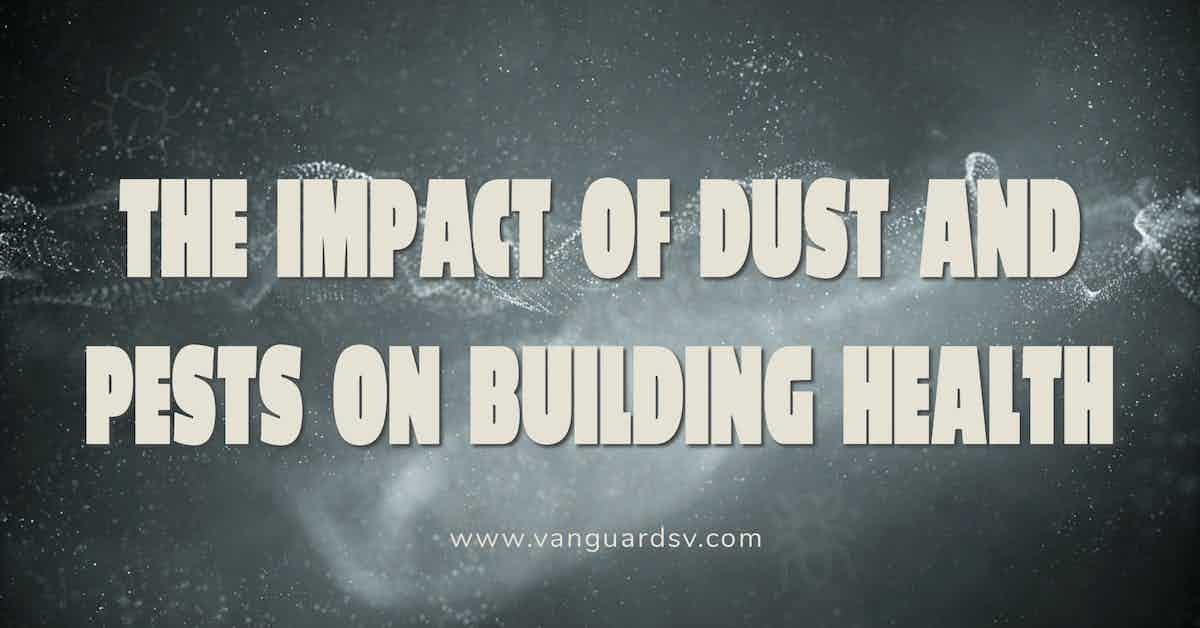Dust and pests significantly impact facility and occupant health and require consistent hygiene intervention strategies coordinated with safe and sustainable facility maintenance practices to prevent incursion, buildup, and other undesirable outcomes.

Dust and Pests Negatively Impact Building Health
Dust and pests are common nuisances that can negatively impact the health of building occupants and the overall cleanliness of a facility.
Dust, for example, often contains a mixture of organic and inorganic substances, including mold, bacteria, and other allergens that can trigger respiratory problems in some individuals.
On a most basic level, dust typically irritates the nose and causes respiratory discomfort, causing symptoms such as cough, congestion, or irritated eyes.
However, with mismanaged household dust, dust buildup can eventually cause allergic reactions from dust allergens, including pet dander, mold spores, pollen, and dust mites.
Outside of the adverse effects on human health, another significant danger of dust buildup is dirty ductwork in your home.
When dust is not filtered from the air and cleaned from surfaces, it can accumulate in your [...] HVAC system.
Once collected, the dust often attracts mold growth which negatively affects your indoor air quality.
Even if you have a quality filter working on your behalf, dust buildup does not support the long-term maintenance of your HVAC system, which can lead to a shortened product lifespan.
Similarly, bugs such as roaches and ants can transmit diseases and cause damage to structures, leading to costly repairs.
Serious, even fatal, diseases can be spread or triggered by pests such as vectors, other insects, rodents, or microbes.
Examples of significant public health problems caused by pests include:
Vector-Borne Diseases.
Asthma and Allergies [, and;]
Microbial Diseases and Infections.
Given the health risks and financial costs associated with these pests, it is crucial to address the challenge of dust and bugs in office buildings.
How Dust and Pests Impact Facility and Occupant Health
Dust and bugs can pose serious health risks to occupants in office buildings.
Dust mites, for instance, are tiny insects that thrive in warm, humid environments and feed on dead skin cells, pet dander, and other organic matter.
They can trigger allergies and asthma, causing respiratory problems for individuals who are sensitive to them.
Similarly, roaches and ants can spread bacteria and viruses, which can lead to food poisoning and transmit diseases such as salmonella and E. coli.
These pests can also cause damage to buildings, leading to costly repairs and renovations.
Furthermore, the presence of dust and bugs can negatively impact the overall cleanliness of a building.
Dust and dirt can accumulate on surfaces, causing the air quality to deteriorate, which can negatively affect the health of occupants.
Bugs can also leave droppings and nests, which can be challenging to clean and unpleasant.
This can create an unprofessional and unsanitary environment that may deter employees, customers, and visitors from entering the building.
Addressing the Challenges of Dust and Pests in Office Buildings
To mitigate these adverse effects, facility managers can implement enhanced cleaning measures, such as regular dusting, vacuuming, and mopping, to remove dust and dirt from surfaces.
This will improve the air quality and help maintain a clean and hygienic environment.
In addition, regular pest control measures, such as extermination and baiting, can help keep bugs and other pests at bay, thereby reducing the risk of disease transmission and damage to the building.
Moreover, enhanced cleaning measures can also help reduce the financial costs associated with dust and bugs.
In addition, maintaining a clean and hygienic environment can improve the overall image of the building, attracting more customers and visitors, which can increase revenue and improve the bottom line.
References & Resources
- 9 Foundations
- Studies are Igniting a Healthy Building Research Revolution
- For Health
- Chapter 5: Indoor Air Pollutants and Toxic Materials
- The Foundations of a Healthy Building
Takeaway
Enhanced cleaning measures, such as regular dusting, vacuuming, mopping, and effective pest control, can help mitigate the adverse effects of dust and pests in public facilities while creating a clean, hygienic, and professional environment.
By implementing these measures, office building managers can protect the occupants' health, maintain cleanliness, and reduce costs associated with dust and bugs.
By taking a proactive approach to these challenges, we can ensure that our office buildings are healthy, clean, and safe for all who use them.
Onboarding and managing the requisite labor and material resources necessary to ensure the highest standards of cleanliness are achieved and maintained may prove cost-prohibitive for many organizations.
Outsourcing is a proven method for onboarding highly in-demand cleaning and disinfection services and experience for a fraction of the price of maintaining a similar service in-house.
If you would like more information regarding the effectiveness of high-performance infection prevention and control measures, or if you would like to schedule a free, no-obligation on-site assessment of your facility's custodial needs, contact us today for a free quote!
In Bakersfield, CA, call (661) 437-3253
In Fresno, CA, call (559) 206-1059
In Valencia, CA, or Santa Clarita, CA, call (661) 437-3253
In Palmdale, CA, or Lancaster, CA, call (661) 371-4756

